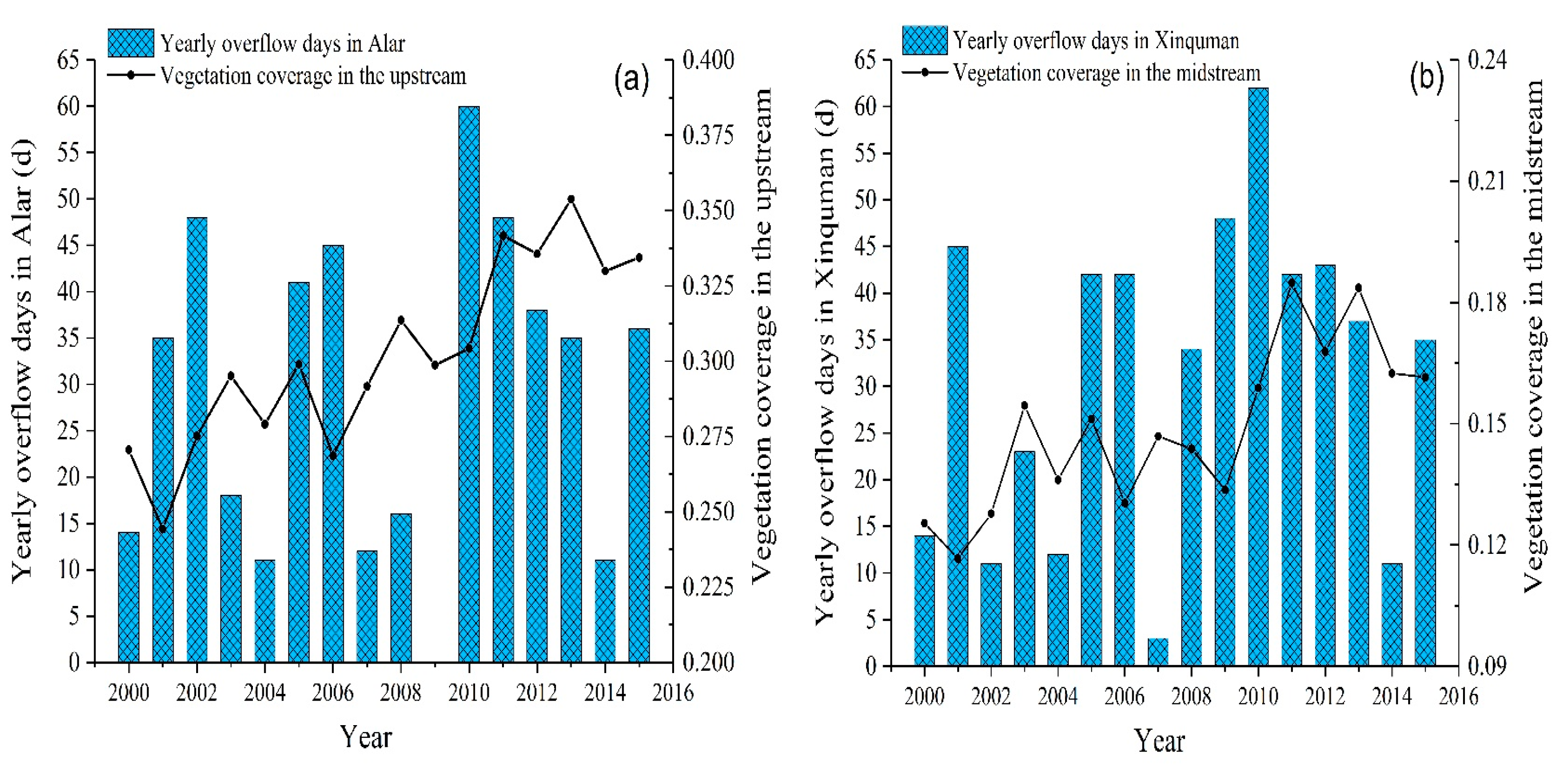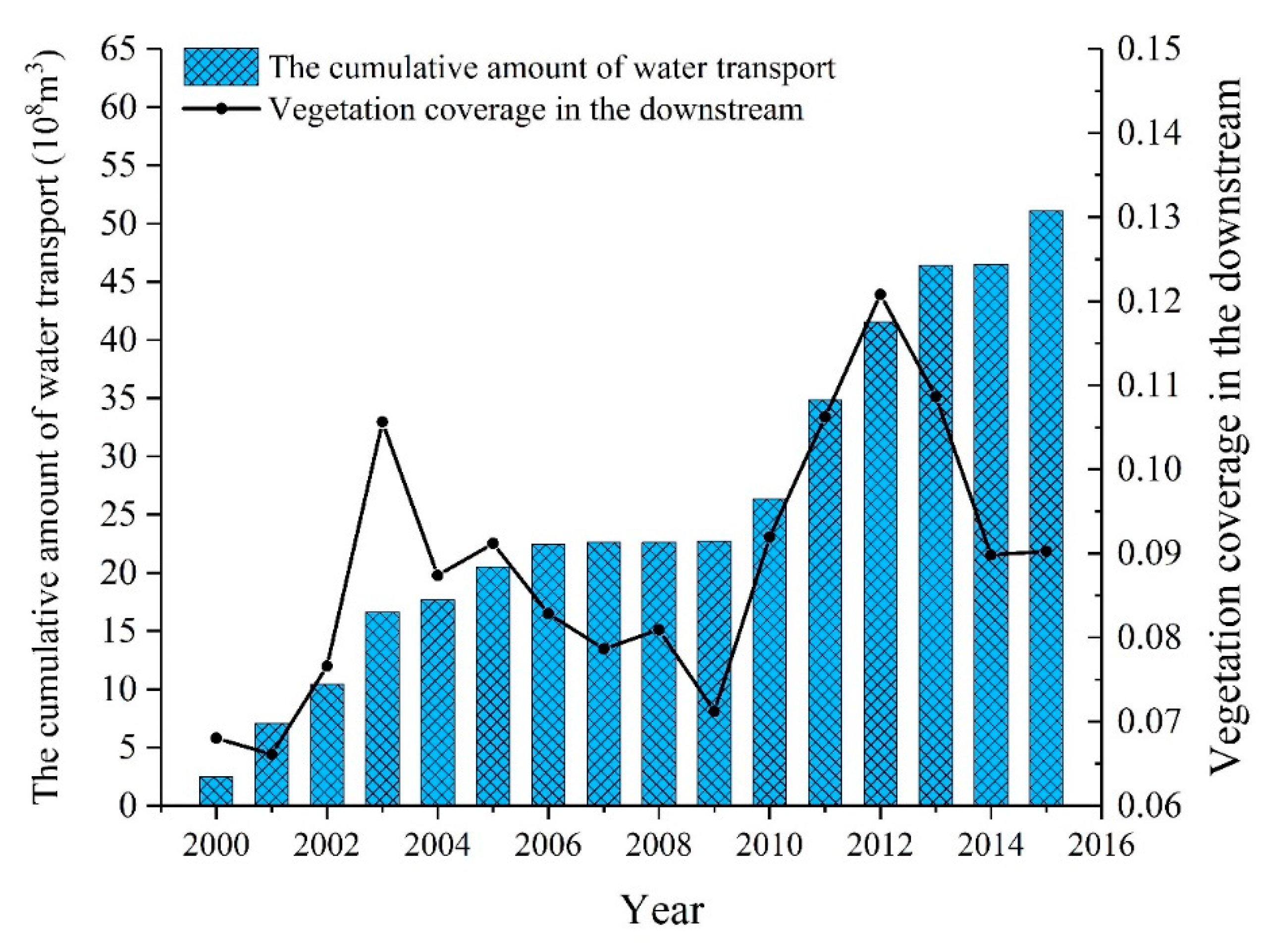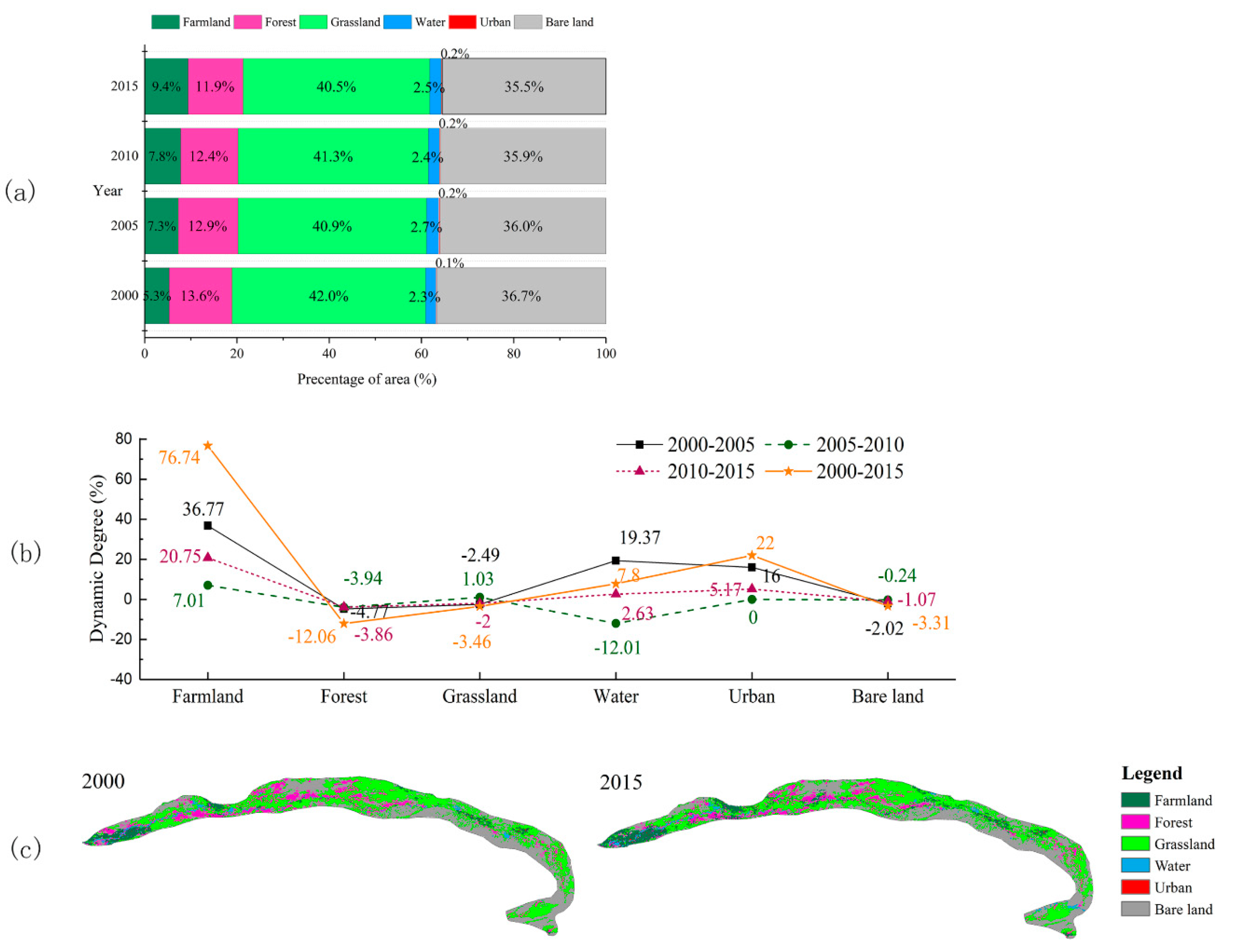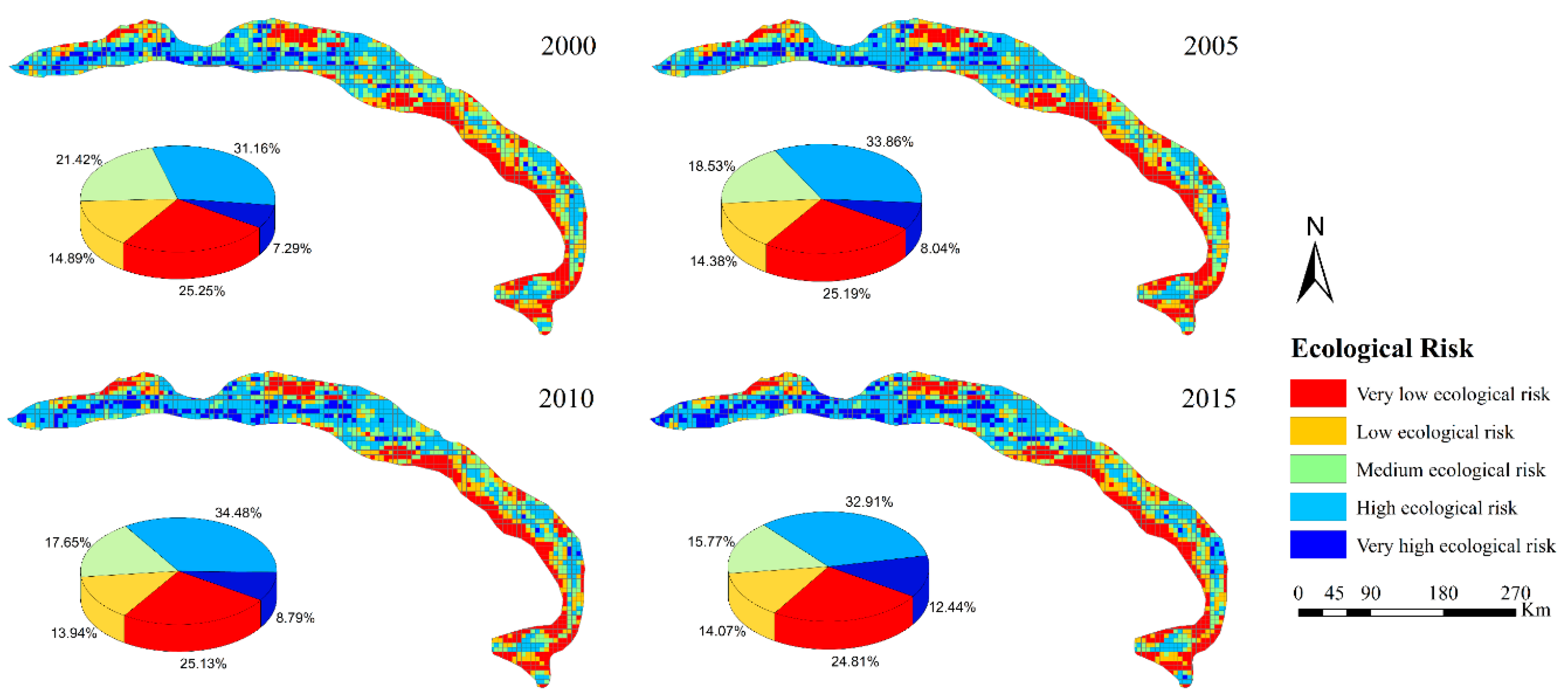Assessing Vegetation Dynamics and Landscape Ecological Risk on the Mainstream of Tarim River, China
Abstract
:1. Introduction
2. Materials and Methods
2.1. Study Area
2.2. Data
2.3. Methods
2.3.1. Calculation and Classification of Vegetation Coverage
2.3.2. Regression Analysis
2.3.3. Correlation Analysis
2.3.4. Ecological Risk Structure
3. Results
3.1. Vegetation Condition and Change
3.1.1. Temporal Variation of Vegetation Coverage
3.1.2. Spatial Patterns of Vegetation Coverage
3.2. Driving Factors of Vegetation Coverage Change
3.2.1. Relationship between Vegetation Coverage Changes and Climatic Variables
3.2.2. Response of Vegetation Coverage to the Overflow Days in the Upstream and Midstream
3.2.3. Response of Vegetation Coverage to the Eco-Water Transport in the Downstream
3.3. Landscape Pattern Condition and Change
3.3.1. Landscape Type Change
3.3.2. Landscape Ecological Risk
3.3.3. Relationship between Vegetation Coverage and ERI
4. Discussion
4.1. Vegetation Dynamics and Its Response to the Hydrological Situation
4.2. Implications of Evolution Results of Landscape Ecological Risk
4.3. Limitations and Future Research Directions
5. Conclusions
Supplementary Materials
Author Contributions
Funding
Conflicts of Interest
References
- Based on Multi-Temporal Remote Sensing Imagery: A Case Study of Yuxian, China. Int. J. Environ. Res. Public Health 2019, 16, 511. [CrossRef] [PubMed] [Green Version]
- Bai, C.; He, H.; Li, Y.; He, W.; Zhao, H.; Mokhtar, A.; Keo, S.; Zhang, C.; Ma, Y.; He, Q. Land cover dynamic change in the Napahai Basin using the optimized random forest model. J. Appl. Remote Sens. 2019, 13, 044158. [Google Scholar] [CrossRef]
- Islam, S.; Zhang, M.; Yang, H.; Ma, M. Assessing inconsistency in global land cover products and synthesis of studies on land use and land cover dynamics during 2001 to 2017 in the southeastern region of Bangladesh. J. Appl. Remote Sens. 2019, 13, 048501. [Google Scholar] [CrossRef]
- Jiang, L.; Guli, J.; Bao, A.; Guo, H.; Ndayisaba, F. Vegetation dynamics and responses to climate change and human activities in Central Asia. Sci. Total Environ. 2017, 599–600, 967–980. [Google Scholar] [CrossRef]
- Shen, Q.; Ma, Y. Did water diversion projects lead to sustainable ecological restoration in arid endorheic basins? Lessons from long-term changes of multiple ecosystem indicators in the lower Heihe River Basin. Sci.Total Environ. 2020, 701, 134785. [Google Scholar] [CrossRef]
- Ling, H.; Guo, B.; Zhang, G.; Xu, H.; Deng, X. Evaluation of the ecological protective effect of the “large basin” comprehensive management system in the Tarim River basin, China. Sci. Total Environ. 2019, 650, 1696–1706. [Google Scholar] [CrossRef]
- Peng, J.; Zong, M.; Hu, Y.n.; Liu, Y.; Wu, J. Assessing Landscape Ecological Risk in a Mining City: A Case Study in Liaoyuan City, China. Sustainability 2015, 7, 8312–8334. [Google Scholar] [CrossRef] [Green Version]
- Liu, X.; Ren, L.; Yuan, F.; Xu, J.; Liu, W. Assessing vegetation response to drought in the Laohahe catchment, North China. Hydrol. Res. 2012, 43, 91–101. [Google Scholar] [CrossRef]
- Feng, D.; Wang, J.; Fu, M.; Liu, G.; Zhang, M.; Tang, R. Spatiotemporal variation and influencing factors of vegetation cover in the ecologically fragile areas of China from 2000 to 2015: A case study in Shaanxi Province. Environ. Sci. Pollut. Res. 2019, 26, 28977–28992. [Google Scholar] [CrossRef]
- Li, F.; Zhu, J.; Deng, X.; Zhao, Y.; Li, S. Assessment and uncertainty analysis of groundwater risk. Environ. Res. 2018, 160, 140–151. [Google Scholar] [CrossRef]
- Nourani, V.; Fard, A.F.; Gupta, H.V.; Goodrich, D.C.; Niazi, F. Hydrological model parameterization using NDVI values to account for the effects of land cover change on the rainfall-runoff response. Hydrol. Res. 2017, 48, 1455–1473. [Google Scholar] [CrossRef]
- Lamqadem, A.A.; Afrasinei, G.M.; Saber, H. Analysis of Landsat-derived multitemporal vegetation cover to understand drivers of oasis agroecosystems change. J. Appl. Remote Sens. 2019, 13, 014517. [Google Scholar] [CrossRef]
- Cao, X.; Chen, X.; Bao, A.; Wang, Q. Response of vegetation to temperature and precipitation in Xinjiang during the period of 1998–2009. J. Arid Land 2011, 3, 94–103. [Google Scholar] [CrossRef] [Green Version]
- Dai, S.; Zhang, B.; Wang, H.; Wang, Y.; Guo, L.; Wang, X.; Li, D. Vegetation cover change and the driving factors over northwest China. J. Arid Land 2011, 3, 25–33. [Google Scholar]
- Xue, L.; Zhu, B.; Wu, Y.; Wei, G.; Liao, S.; Yang, C.; Wang, J.; Zhang, H.; Ren, L.; Han, Q. Dynamic projection of ecological risk in the Manas River basin based on terrain gradients. Sci. Total Environ. 2019, 653, 283–293. [Google Scholar] [CrossRef]
- Xie, H.; Wang, P.; Huang, H. Ecological risk assessment of land use change in the Poyang Lake Eco-economic Zone, China. Int. J. Environ. Res. Public Health 2013, 10, 328–346. [Google Scholar] [CrossRef] [Green Version]
- Cui, L.; Zhao, Y.; Liu, J.; Han, L.; Ao, Y.; Yin, S. Landscape ecological risk assessment in Qinling Mountain. Geol. J. 2018, 53, 342–351. [Google Scholar] [CrossRef]
- Li, J.; Pu, R.; Gong, H.; Luo, X.; Ye, M.; Feng, B. Evolution Characteristics of Landscape Ecological Risk Patterns in Coastal Zones in Zhejiang Province, China. Sustainability 2017, 9, 584. [Google Scholar] [CrossRef] [Green Version]
- Guan, W.; Wei, H.; Zhong, J.; Huo, A.; Du, W.; Zheng, X. Remote Sensing Monitoring of Vegetation Cover Change in Tarim River Basin. Bull. Soil Water Conserv. 2018, 38, 244–248, 260. [Google Scholar]
- Du, J.-Q.; Jiaerheng, A.; Zhao, C.; Fang, G.-L.; Yin, J.-Q.; Xiang, B.; Yuan, X.-J.; Fang, S.-F. Dynamic changes in vegetation NDVI from 1982 to 2012 and its responses to climate change and human activities in Xinjiang, China. Ying Yong Sheng Tai Xue Bao = J. Appl. Ecol. 2015, 26, 3567–3578. (In Chinese) [Google Scholar]
- Wei, Z.; Wang, D.; Zhang, C.; Liu, X.; Zhang, H. Response of Vegetation Cover to Climate Change and Human Activities in Northwest China During 1999–2010. J. Desert Res. 2014, 34, 1665–1670. [Google Scholar]
- Wang, X.; Xu, H.; Ling, H.; Zhao, X.; Pan, C.; Wang, C. Effects of ecological water conveyance on recovery value of vegetation in the lower reaches of Tarim river. Agric. Res. Arid Areas 2017, 35, 160–166. [Google Scholar]
- Mansur, S.; Nurkamil, Y. Oasis land use change and its hydrological response to Tarim River Basin. Geogr. Res. 2010, 29, 2251–2260. [Google Scholar]
- Bao, A.; Huang, Y.; Ma, Y.; Guo, H.; Wang, Y. Assessing the effect of EWDP on vegetation restoration by remote sensing in the lower reaches of Tarim River. Ecol. Indic. 2017, 74, 261–275. [Google Scholar] [CrossRef]
- Gu, X.; Zhang, Q.; Singh, V.P.; Chen, X.; Liu, L. Nonstationarity in the occurrence rate of floods in the Tarim River basin, China, and related impacts of climate indices. Glob. Planet. Chang. 2016, 142, 1–13. [Google Scholar] [CrossRef] [Green Version]
- Chinese Geospatial Data Cloud. Available online: http://www.gscloud.cn (accessed on 20 May 2020).
- Chinese Meteorological Data Sharing Service System. Available online: http://data.cma.cn (accessed on 20 May 2020).
- Resources and Environment Science Data Center, Chinese Academy of Sciences. Available online: http://www.resdc.cn (accessed on 20 May 2020).
- Xia, J.; Yi, G.; Zhang, T.; Zhou, X.; Miao, J.; Bie, X. Interannual variation in the start of vegetation growing season and its response to climate change in the Qinghai-Tibet Plateau derived from MODIS data during 2001 to 2016. J. Appl. Remote Sens. 2019, 709, 136155. [Google Scholar] [CrossRef]
- Xiao, Q.; Tao, J.; Xiao, Y.; Qian, F. Monitoring vegetation cover in Chongqing between 2001 and 2010 using remote sensing data. Environ. Monit. Assess 2017, 189, 493. [Google Scholar] [CrossRef]
- Lankau, M.J.; Scandura, T.A. An investigation of personal learning in mentoring relationships: Content, antecedents, and consequences. Acad. Manag. J. 2002, 45, 779–790. [Google Scholar]
- Park, N.; Kee, K.F.; Valenzuela, S. Being Immersed in Social Networking Environment: Facebook Groups, Uses and Gratifications, and Social Outcomes. Cyberpsychol. Behav. 2009, 12, 729–733. [Google Scholar] [CrossRef] [Green Version]
- Tian, Y.; Liang, M. The NDVI Characteristics of Vegetation and Its Ten-day Response to Temperature and Precipitation in Beibu Gulf Coastal Region. J. Nat. Resour. 2016, 31, 488–502. [Google Scholar]
- Yu, G.A.; Li, Z.; Huang, H.; Liu, X. Human impacts on fluvial processes in a very arid environment: Case of Tarim River in China. Adv. Water Sci. 2017, 28, 183–192. [Google Scholar]
- Mao, D.; Wang, Z.; Luo, L.; Ren, C. Integrating AVHRR and MODIS data to monitor NDVI changes and their relationships with climatic parameters in Northeast China. Int. J. Appl. Earth Obs. Geoinf. 2012, 18, 528–536. [Google Scholar] [CrossRef]
- Du, J.; Shu, J.; Yin, J.; Yuan, X.; Jiaerheng, A.; Xiong, S.; He, P.; Liu, W. Analysis on spatio-temporal trends and drivers in vegetation growth during recent decades in Xinjiang, China. Int. J. Appl. Earth Obs. Geoinf. 2015, 38, 216–228. [Google Scholar] [CrossRef]
- Zhou, D.; Shen, Y.; Chen, Y.; Cuo, Y.; Zhang, B. Estimation of ecological water requirement of desert vegetation in the arid region of Northwest China. Chin. J. Ecol. 2015, 34, 670–680. [Google Scholar]
- Guo, J.; Wu, X.; Dong, G.; Li, Y.; Wu, R. Vegetation Coverage Change and Relative Effects of Driving Factors Based on MODIS /NDVI in the Tarim River Basin. Arid Zone Res. 2017, 34, 621–629. [Google Scholar]
- Yan, J.; Lu, G.; Xu, H.; Xu, X.; Ling, H. Spatial-Temporal Variations in Vegetation Cover and Evapotranspiration and Their Relationship in Tarim River During 2000–2014. Bull. Soil Water Conserv. 2018, 38, 248–255. [Google Scholar]
- Hao, X.; Li, W. Impacts of ecological water conveyance on groundwater dynamics and vegetation recovery in the lower reaches of the Tarim River in northwest China. Environ. Monit. Assess. 2014, 186, 7605–7616. [Google Scholar] [CrossRef]
- Wang, S.-Y.; Liu, J.-S.; Ma, T.-B. Dynamics and changes in spatial patterns of land use in Yellow River Basin, China. Land Use Policy 2010, 27, 313–323. [Google Scholar] [CrossRef]
- Zumrat, E.; Tursun, Q.; Ayxam, I.; Mnisahan, T.; Han, G. The land—Use changes and its environmental effects in Tarim River. J. Arid Land Resour. Environ. 2011, 25, 29–35. [Google Scholar]
- Sun, C.; Gong, L.; Ma, Y.; Zhu, H.; Zhao, J. Temporal and spatial pattern analysis of land use in typical oasis in the upper reaches of the Tarim River. J. Northwest A F Univ. Nat. Sci. Ed. 2020, 48, 1–10. [Google Scholar]
- Zhang, J.; Long, A.; Yu, J.; Ren, G.; Su, S.; Li, J. GIS and RS-based analysis on temporal and spatial changes of LUCC and landscape patterns in Tarim River Basin from 1990 to 2015. Water Resour. Hydropower Eng. 2019, 50, 18–26. [Google Scholar]
- Day, C.L.; Lew, R.A.; Mihm, M.C.; Harris, M.N.; Kopf, A.W.; Sober, A.J.; Fitzpatrick, T.B. The Natural Break Points for Primary-Tumor Thickness in Clinical Stage-I Melanoma. N. Eng. J. Med. 1981, 305, 1155. [Google Scholar]
- Yang, F.; Xue, L.; Wei, G.; Chi, Y.; Yang, G. Study on the dominant causes of streamflow alteration and effects of the current water diversion in the Tarim River Basin, China. Hydrol. Proc. 2018, 32, 3391–3401. [Google Scholar] [CrossRef]
- Xu, M.; Wang, X.; Sun, T.; Wu, H.; Li, X.; Kang, S. Water balance change and its implications to vegetation in the Tarim River Basin, Central Asia. Quat. Int. 2019, 523, 25–36. [Google Scholar] [CrossRef]
- Liu, T.; Fang, H.; Willems, P.; Bao, A.M.; Chen, X.; Veroustraete, F.; Dong, Q.H. On the relationship between historical land-use change and water availability: The case of the lower Tarim River region in northwestern China. Hydrol. Proc. 2013, 27, 251–261. [Google Scholar] [CrossRef]
- Su, B.; Wang, A.; Wang, G.; Wang, Y.; Jiang, T. Spatiotemporal variations of soil moisture in the Tarim River basin, China. Int. J. Appl. Earth Obs. Geoinf. 2016, 48, 122–130. [Google Scholar] [CrossRef]
- Wu, J.; Tang, D. The influence of water conveyances on restoration of vegetation to the lower reaches of Tarim River. Environ. Earth Sci. 2010, 59, 967–975. [Google Scholar] [CrossRef]
- Song, Y.; Bao, A.; Huang, Y.; Wang, Y.; Jiang, L. Eco-environmental Change in the Main Stream Area of the Tarim River before and after Implementing the Comprehensive Management Project. Arid Zone Res. 2016, 33, 230–238. [Google Scholar]
- Li, L.; Zhang, X.; Chen, C.; Shen, M. Ecological effects of water conveyance on the lower reaches of Tarim River in recent twenty years. Arid Land Geog. 2018, 41, 238–247. [Google Scholar]
- Huang, F.; Chunyu, X.; Zhang, D.; Chen, X.; Ochoa, C.G. A framework to assess the impact of ecological water conveyance on groundwater-dependent terrestrial ecosystems in arid inland river basins. Sci. Total Environ. 2020, 709, 136156. [Google Scholar] [CrossRef]
- Aishan, T.; Halik, U.; Cyffka, B.; Kuba, M.; Abliz, A.; Baidourela, A. Monitoring the hydrological and ecological response to water diversion in the lower reaches of the Tarim River, Northwest China. Quat. Int. 2013, 311, 155–162. [Google Scholar] [CrossRef]
- Nie, Q.; Xu, J.; Ji, M.; Cao, L.; Yang, Y.; Hong, Y. The Vegetation Coverage Dynamic Coupling with Climatic Factors in Northeast China Transect. Environ. Manag. 2012, 50, 405–417. [Google Scholar] [CrossRef] [PubMed]
- Yao, J.; Chen, Y.; Zhao, Y.; Mao, W.; Xu, X.; Liu, Y.; Yang, Q. Response of vegetation NDVI to climatic extremes in the arid region of Central Asia: A case study in Xinjiang, China. Theor. Appl. Climatol. 2018, 131, 1503–1515. [Google Scholar] [CrossRef]
- Wang, P.; Zhang, Y.; Yu, J.; Fu, G.; Ao, F. Vegetation dynamics induced by groundwater fluctuations in the lower Heihe River Basin, northwestern China. J. Plant Ecol. 2011, 4, 77–90. [Google Scholar] [CrossRef]
- Zhu, J.; Yu, J.; Wang, P.; Yu, Q.; Eamus, D. Variability in groundwater depth and composition and their impacts on vegetation succession in the lower Heihe River Basin, north-western China. Mar. Freshwater Res. 2014, 65, 206–217. [Google Scholar] [CrossRef]
- Zhang, Y.; Yu, J.; Wang, P.; Fu, G. Vegetation responses to integrated water management in the Ejina basin, northwest China. Hydrol. Proc. 2011, 25, 3448–3461. [Google Scholar] [CrossRef]
- Chen, Y.; Chen, Y.; Xu, C.; Ye, Z.; Li, Z.; Zhu, C.; Ma, X. Effects of ecological water conveyance on groundwater dynamics and riparian vegetation in the lower reaches of Tarim River, China. Hydrol. Proc. 2010, 24, 170–177. [Google Scholar] [CrossRef]
- Gong, J.; Yang, J.; Tang, W. Spatially Explicit Landscape-Level Ecological Risks Induced by Land Use and Land Cover Change in a National Ecologically Representative Region in China. Int. J. Environ. Res. Public Health 2015, 12, 14192–14215. [Google Scholar] [CrossRef] [Green Version]
- Fan, J.; Wang, Y.; Zhou, Z.; You, N.; Meng, J. Dynamic Ecological Risk Assessment and Management of Land Use in the Middle Reaches of the Heihe River Based on Landscape Patterns and Spatial Statistics. Sustainability 2016, 8, 536. [Google Scholar] [CrossRef] [Green Version]
- Liang, E.; Zhang, J.; Yang, W. Spatiotemporal Variation of Landscape Ecological Vulnerability in Oasis in the Manas River Basin, Xinjiang. Arid Zone Res. 2017, 34, 950–957. [Google Scholar]
- Xu, X.; Yang, G.; Tan, Y.; Zhuang, Q.; Li, H.; Wan, R.; Su, W.; Zhang, J. Ecological risk assessment of ecosystem services in the Taihu Lake Basin of China from 1985 to 2020. Sci. Total Environ. 2016, 554–555, 7–16. [Google Scholar] [CrossRef] [PubMed]
- Zhang, X.; Shi, P.; Luo, J.; Liu, H.; Wei, W. The Ecological Risk Assessment of Arid Inland River Basin at the Landscape Scale:A Case Study on Shiyang River Basin. J. Nat. Resour. 2014, 29, 410–419. [Google Scholar]
- Muyibul, Z.; Xia, J.; Muhtar, P.; Shi, Q.; Zhang, R. Spatiotemporal changes of land use/cover from 1995 to 2015 in an oasis in the middle reaches of the Keriya River, southern Tarim Basin, Northwest China. Catena 2018, 171, 416–425. [Google Scholar] [CrossRef]
- Liu, S.; Yang, Z.; Cui, B. Effects of road on landscape and its ecological risk assessment: A case study of Lancangjiang River valley. Chin. J. Ecol. 2005, 24, 897–901. [Google Scholar]
- Bartolo, R.E.; van Dam, R.A.; Bayliss, P. Regional Ecological Risk Assessment for Australia’s Tropical Rivers: Application of the Relative Risk Model. Hum. Ecol. Risk Assess. An Int. J. 2012, 18, 16–46. [Google Scholar] [CrossRef]
- Macfarlane, W.W.; Gilbert, J.T.; Jensen, M.L.; Gilbert, J.D.; Hough-Snee, N.; McHugh, P.A.; Wheaton, J.M.; Bennett, S.N. Riparian vegetation as an indicator of riparian condition: Detecting departures from historic condition across the North American West. J. Environ. Manag. 2017, 202, 447–460. [Google Scholar] [CrossRef]
- Gu, F.; Liu, W. Applications of remote sensing and GIS to the assessment of riparian zones for environmental restoration in agricultural watersheds. Geo-Spat. Inf. Sci. 2010, 13, 263–268. [Google Scholar] [CrossRef]
- Kozak, J.P.; Bennett, M.G.; Piazza, B.P.; Remo, J.W.F. Towards dynamic flow regime management for floodplain restoration in the Atchafalaya River Basin, Louisiana. Environ. Sci. Policy 2016, 64, 118–128. [Google Scholar] [CrossRef] [Green Version]
- Hunter, J.C.; Willett, K.B.; McCoy, M.C.; Quinn, J.F.; Keller, K.E. Prospects for preservation and restoration of riparian forests in the Sacramento Valley, California, USA. Environ. Manag. 1999, 24, 65–75. [Google Scholar]
- Schaich, H.; Karier, J.; Konold, W. Rivers, regulation and restoration: Land use history of floodplains in a peri-urban landscape in Luxembourg, 1777–2000. Eur. Countrys. 2011, 3, 241–264. [Google Scholar] [CrossRef] [Green Version]










| Classification. | 2000–2005 | 2006–2010 | 2011–2015 | 2000–2015 | |||||
|---|---|---|---|---|---|---|---|---|---|
| Area/km2 | % | Area/km2 | % | Area/km2 | % | Area/km2 | % | ||
| ≤ −0.02 | Severe degradation | 545 | 1.6 | 1675 | 4.8 | 5706 | 16.4 | 167 | 0.5 |
| −0.02 < < −0.005 | Slight degradation | 2005 | 5.8 | 2534 | 7.3 | 12,395 | 35.7 | 2095 | 6.0 |
| 0.005 ≤ ≤ 0.005 | Stability | 16,064 | 46.2 | 8751 | 25.2 | 11,580 | 33.3 | 23,219 | 66.8 |
| 0.005 < 0.02 | Slight improvement | 10,383 | 29.9 | 16,359 | 47.1 | 2917 | 8.4 | 7073 | 20.4 |
| 0.02 < ≤ 0.05 | Obvious improvement | 4421 | 12.7 | 4445 | 12.8 | 1654 | 4.8 | 1930 | 5.6 |
| > 0.05 | Significant improvement | 1323 | 3.8 | 977 | 2.8 | 487 | 1.4 | 255 | 0.7 |
| Region | Precipitation | Temperature | ||
|---|---|---|---|---|
| PCC | LPCC | PCC | LPCC | |
| Upstream | 0.098 | −0.127 | −0.172 | −0.265 |
| Midstream | −0.382 | −0.136 | −0.174 | 0.057 |
| Downstream | 0.331 | 0.224 | 0.133 | 0.053 |
| Related Item | Annual Overflow Days | Cumulative Overflow Days | |||||
|---|---|---|---|---|---|---|---|
| Pearson | p-Value | Equation | Pearson | p-Value | Equation | ||
| Upstream | 0 | 0.101 | 0.710 | - | 0.89 ** | 0.000 | y = 0.0002x + 0.256 R2 = 0.792 |
| Vegetation | 1 | 0.262 | 0.346 | - | 0.885 ** | 0.000 | y = 0.0002x + 0.258 R2 = 0.783 |
| Cover | 2 | 0.3 | 0.297 | - | 0.829 ** | 0.000 | y = 0.0002x + 0.271 R2 = 0.687 |
| 3 | 0.235 | 0.439 | - | 0.781 ** | 0.002 | y = 0.0002x + 0.276 R2 = 0.609 | |
| Midstream | 0 | 0.212 | 0.431 | - | 0.797 ** | 0.000 | y = 0.0001x + 0.125 R2 = 0.634 |
| Vegetation | 1 | 0.37 | 0.175 | - | 0.772 ** | 0.001 | y = 0.0001x + 0.128 R2 = 0.596 |
| Cover | 2 | 0.767 ** | 0.001 | y = 0.0008x + 0.1266 R2 = 0.588 | 0.707 ** | 0.005 | y = 0.00009x + 0.134 R2 = 0.499 |
| 3 | 0.285 | 0.346 | - | 0.591 * | 0.034 | y = 0.00008x + 0.140 R2 = 0.349 | |
| Diversion | Starting Time (dd/mm/yy) | Ending Time (dd/mm/yy) | Duration (day) | Quantity (108 m3) | Distance (km) |
|---|---|---|---|---|---|
| 1st | 14/05/2000 | 13/07/2000 | 61 | 0.99 | 110 |
| 2nd | 03/11/2000 | 14/02/2001 | 104 | 2.27 | 218 |
| 3rd (1st period) | 01/04/2001 | 06/07/2001 | 97 | 1.84 | 310 |
| 3rd (2st period) | 12/09/2001 | 17/11/2001 | 67 | 1.98 | 363 |
| 4th | 20/07/2002 | 10/11/2002 | 114 | 3.31 | 363 |
| 5th (1st period) | 03/03/2003 | 11/07/2003 | 131 | 3.40 | 363 |
| 5th (2st period) | 12/09/2003 | 07/11/2003 | 56 | 2.85 | 363 |
| 6th (1st period) | 22/04/2004 | 25/06/2004 | 64 | 1.02 | 363 |
| 6th (2st period) | 01/08/2004 | 15/09/2004 | 46 | 2.30 | 238 |
| 7th (1st period) | 18/04/2005 | 07/06/2005 | 32 | 0.52 | 363 |
| 7th (2st period) | 30/08/2005 | 02/11/2005 | 65 | 2.30 | 340 |
| 8th | 25/09/2006 | 30/11/2006 | 66 | 1.96 | 110 |
| 9th | 15/10/2007 | 21/11/2007 | 38 | 0.14 | 110 |
| 10th | 12/05/2009 | 20/06/2009 | 39 | 0.11 | 363 |
| 11th | 25/06/2010 | 11/11/2010 | 139 | 3.64 | 363 |
| 12th (1st period) | 07/01/2011 | 25/01/2011 | 19 | 0.37 | 363 |
| 12th (2st period) | 25/06/2011 | 23/11/2011 | 151 | 8.15 | 363 |
| 13th | 27/04/2012 | 28/11/2012 | 216 | 6.67 | 265 |
| 14th (1st period) | 25/04/2013 | 29/05/2013 | 35 | 0.14 | 363 |
| 14th (2st period) | 06/08/2013 | 05/11/2013 | 92 | 4.74 | 363 |
| 15th | 17/06/2014 | 26/06/2014 | 10 | 0.07 | 172 |
| 16th | 18/08/2015 | 05/11/2015 | 80 | 4.61 | 363 |
| Related Item | Eco-Water Transport | Cumulative Eco-Water Transport | |||||
|---|---|---|---|---|---|---|---|
| Pearson | p-Value | Formula | Pearson | p-Value | Formula | ||
| Downstream | 0 | 0.641 ** | 0.007 | y = 0.0038x + 0.0763 R2 = 0.411 | 0.649 ** | 0.006 | y = 0.0007x + 0.0706 R2 = 0.422 |
| Vegetation | 1 | 0.570 * | 0.026 | y = 0.0032 x + 0.0799 R2 = 0.325 | 0.469 | 0.078 | - |
| Cover | 2 | 0.365 | 0.199 | - | 0.207 | 0.477 | - |
| 3 | −0.287 | 0.342 | - | −0.012 | 0.969 | - | |
| Variables | Landscape Loss Degree (Ri) | |||||||
|---|---|---|---|---|---|---|---|---|
| Model 1 | Model 2 | Model 3 | Model 4 | |||||
| B | Std E | B | Std E | B | Std E | B | Std E | |
| Constant (a) | 0.018 | 0.002 | 0.011 | 0.002 | −0.026 | 0.006 | −0.021 | 0.006 |
| Ci | 0.096 | 0.008 | 0.209 | 0.023 | 0.323 | 0.023 | 0.324 | 0.021 |
| Ni | −0.008 | 0.002 | −0.013 | 0.001 | −0.013 | 0.001 | ||
| Di | −0.063 | 0.024 | ||||||
| Fi | 0.207 | 0.033 | 0.236 | 0.032 | ||||
| R2 | 0.826 | 0.904 | 0.958 | 0.966 | ||||
© 2020 by the authors. Licensee MDPI, Basel, Switzerland. This article is an open access article distributed under the terms and conditions of the Creative Commons Attribution (CC BY) license (http://creativecommons.org/licenses/by/4.0/).
Share and Cite
Zhang, H.; Xue, L.; Wei, G.; Dong, Z.; Meng, X. Assessing Vegetation Dynamics and Landscape Ecological Risk on the Mainstream of Tarim River, China. Water 2020, 12, 2156. https://doi.org/10.3390/w12082156
Zhang H, Xue L, Wei G, Dong Z, Meng X. Assessing Vegetation Dynamics and Landscape Ecological Risk on the Mainstream of Tarim River, China. Water. 2020; 12(8):2156. https://doi.org/10.3390/w12082156
Chicago/Turabian StyleZhang, Hui, Lianqing Xue, Guanghui Wei, Zengchuan Dong, and Xianyong Meng. 2020. "Assessing Vegetation Dynamics and Landscape Ecological Risk on the Mainstream of Tarim River, China" Water 12, no. 8: 2156. https://doi.org/10.3390/w12082156






